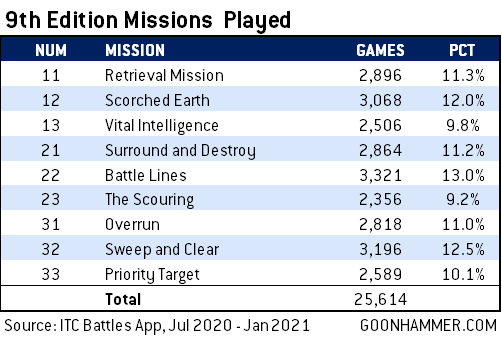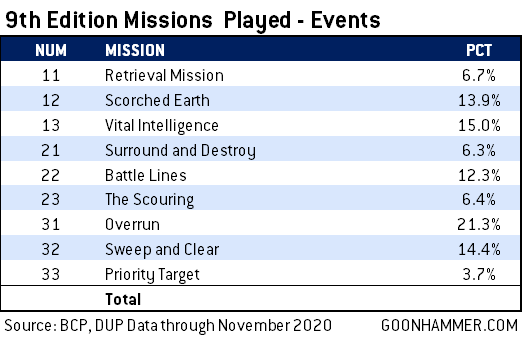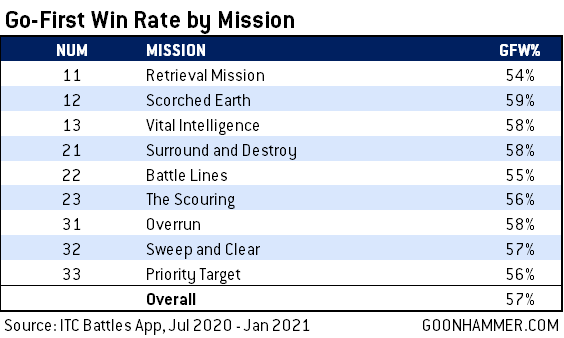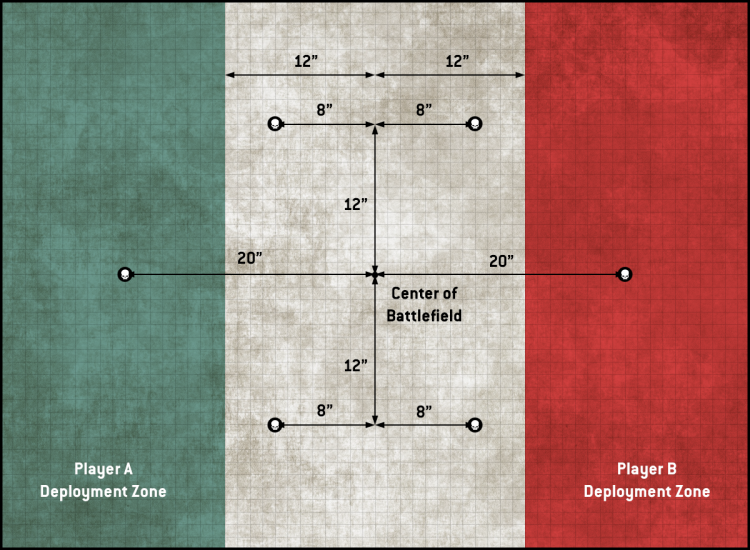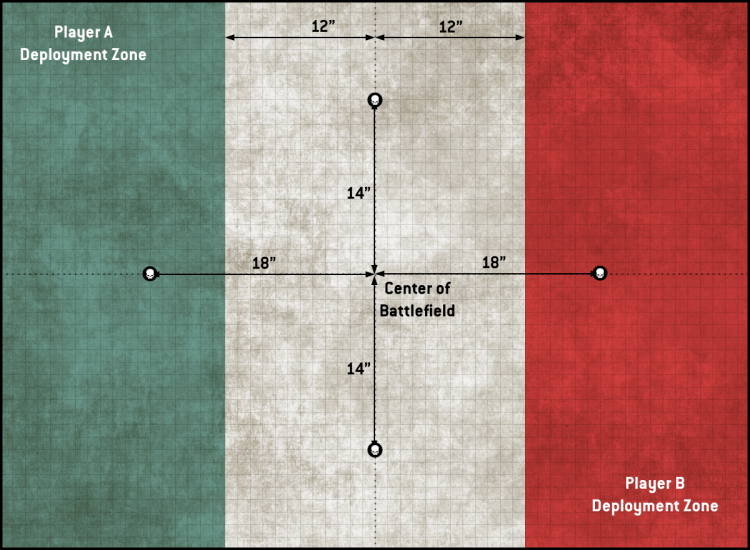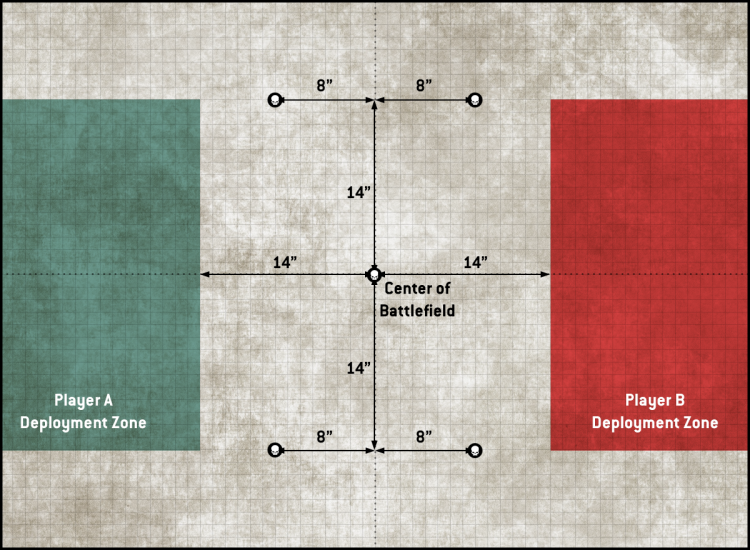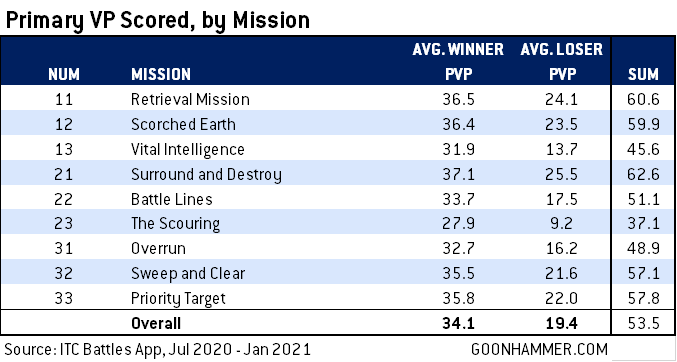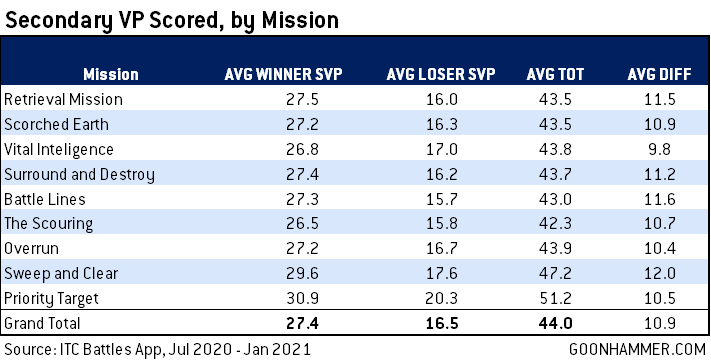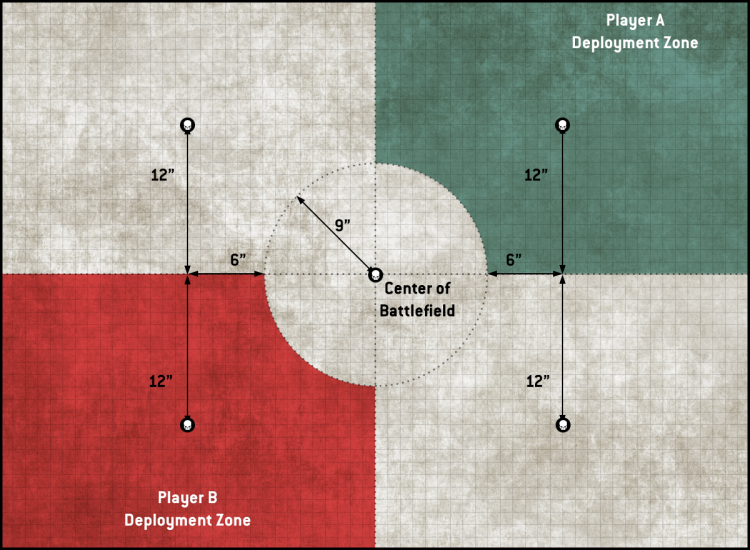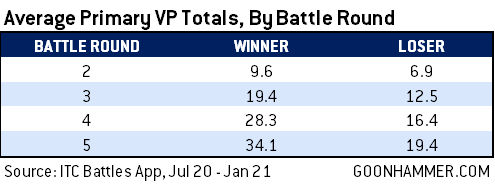In this week’s Hammer of Math we’re taking a look at the missions players pick in 40k and the impact that choice has on the game. If you have a math-related question you’d like to see answered in a future article, you can use this form to submit it.
Howdy math fans! Kevin’s taking a week off to recharge his batteries so today I’m here to talk about some of the data we had “left over” from our last Meta Review article. There’s a ton of data that we have to play with but we’re always constrained by the limits of time and narrative when we sit down to write our analyses – we have to churn them out in a few days once we get the data, and on top of that we need to write an article that’s still legible to the average reader, which means identifying certain narrative threads and doing analysis around those rather than just dumping out everything we know into the article (and even with this restrained approach, those articles end up being six thousand plus words). So what I’ve got for you this week is some of the analysis work we did for the previous Meta Review that didn’t make it in because it didn’t fit with any of the narrative threads we wanted to talk about out last time around. Anyways, here’s 5 or so interesting things I noticed pulling data for the missions the last time around.
A note on Methodology: The data I’m using here comes from two sources:
- The ITC Battles App, an amazing app which players can use to log and track their games from start to finish.
- Best Coast Pairings/Down Under Pairings, the premier software for running 40k tournaments
Big thanks to both groups for providing the data used here.
1. Players tend to play missions pretty evenly, but events may not
When we look at game data in the ITC Battles app, what we see is that generally, players seem like they’re generating missions randomly, or close enough that there’s a pretty even distribution of missions being played for the Strike Force GT missions.
Why Scorched Earth, Battle Lines, and Sweep and Clear ended up with a higher concentration of games, I’m not sure. And the reason I’m not sure is because these numbers don’t necessarily line up with events – we’ve given recommendations before on which missions may be better than others, albeit with more limited data – but our pull of tournament mission data in December suggests that some missions are much, much more common than others:
Specifically, Overrun gets a significantly larger amount of play, while Priority Target, The Scouring, and Retrieval Mission are pretty rare. There are a few potential reasons for this: The Priority Target mission secondary can completely skew the game (as we’ll discuss later), while the Scouring has some of the smallest deployment zones in the game, and may make for uncomfortable play for horde armies. Note however that our mission sample for events is much smaller, and so these numbers may shift dramatically over time if TOs decide to change their preferences.
2. Go-First Win Rates May Be Affected by Deployment Zone
This is something we’ve looked at before and had mixed results on – we’ve previously seem some variation in the chances a player with the first turn will win based on the mission, but not enough to make hard determinations around. We previously examined a number of factors on the missions in a regression analysis, looking at things like number of objective markers and the number in player deployment zones, but to little effect. However this new batch of data does suggest that there’s a potential mission impact that we missed last time: The three missions posting the lowest go-first win rates – Retrieval Mission, Battle Lines, and The Scouring, all use long-ways deployment (or “Hammer and Anvil” for the veterans among you), which means that they have both deployment zones spaced further apart and give players an opportunity to deploy units deeper in their deployment zones. Similarly, Priority Target pulls a similar trick, albeit with diagonal deployment zones spaced 30″ apart.
This suggests that one of the key factors in go-first wins and reducing go-first win rates is placing armies further apart, reducing first turn charges, limiting the amount of enemy shooting that can happen, and generally reducing the amount of damage a player can do to a careful opponent before their first chance to act. There’s also the matter of being first to score, and there are some interesting effects to look at there.
Wings: Another potential factor here is that Hammer and Anvil deployment gives players – particularly the second player – a much more constrained front to defend, meaning the first player gets less of a chance to dictate how much the engagement spreads out. And with that, I don’t even think it’s so much that H&I prevents turn one charges outright, it’s more that if your opponent goes for one you’re guaranteed to have other resources close enough to respond
Retrieval Mission Deployment
Battle Lines Deployment
The Scouring Deployment
In our prior analyses we’ve put more emphasis on the ability to capture objectives on turn one, since there seems to be about a 4-point gap in primary VP scoring between the losing player in games where the winner went first vs. second, but the specific way in which those point totals are effected has been a bit more difficult to parse out.
3. Missions with more Deployment Zone Objectives Lead to Higher-Scoring Games
Looking at the primary VP scored for both players shows that average scores vary pretty widely. If we look at the number of objective markers placed for each mission, and more importantly, the number of objective markers in each deployment zone at the start of the game, we find a very strong positive correlation between the two – the missions that put two objective markers in each player’s deployment zone lead to much higher primary VP scores, while missions with fewer, and The Scouring doesn’t give players any objectives in their deployment zone – lead to lower-scoring games. The Scouring is also particularly brutal for the losing player – while scores are generally lower, losing players on The Scouring tend to score an average of only 9 primary VPs. That’s the lowest of any mission by a wide margin.
Note that naturally higher primary scores will lead to smaller point differentials in primary VP scoring between the winner and the loser, which means closer, higher-scoring games.
Although higher-scoring games tended to have closer scores, they weren’t significantly more likely to create comeback opportunities – the player coming into the fifth battle round behind on primary VP only came form behind to win in about 12% of games, regardless of mission.
What about Secondary objectives, you ask? Well as you might expect those aren’t impacted nearly as much – scoring tends to be about the same for secondaries regardless of mission, with two notable exceptions.
The first is on Sweep and Clear, which has the largest average gap between winners and losers when it comes to secondary objectives – this is also the only mission with the “Search and Destroy” style deployment zones, i.e. the one with table quarters deployment and the 9″ bubble from the center of the battlefield.
Search and Destroy/Sweep and Clear Deployment
The other is Priority Target, in which players tend to score significantly more points for secondary objectives on average (although secondary VP differences between the winner and loser appear to be the same). This is no coincidence – it’s due entirely the Priority Targets mission secondary objective. Speaking of which…
4. Most Mission Secondary Objectives are Bad, but Priority Targets is a Must-Take
Of course, primary objectives are only half the story when it comes to winning games – there are also secondary objectives to consider, and each mission offers its own secondary objective option. For the most part, these are pretty bad – the median average score for secondary objectives in the 2020 GT missions pack is 4.7 points. All but two mission secondaries lead to lower average scores than that.
Both of these objectives are among the better options in the game; Direct Assault rewards you for controlling the middle of the table but gives you an alternative option if your opponent is playing very aggressively. One thing we hypothesized when we saw this result was that there’s a high scoring differential for Direct Assault between going first and going second, but so far the data doesn’t really seem to support that – average VP scored are roughly the same for players going first vs. second, though we do see higher Direct Assault Secondary Objective scores for the winner in games where the winner goes second rather than first.
Priority Targets is the game’s easiest to score secondary, with the highest average score of any objective in the game and a relatively low amount of variance to boot – it turns out controlling a single objective marker near your deployment zone for the entire game isn’t particularly difficult. If you’re playing Priority Target, take the mission secondary. If you don’t think you can score it, well you’re probably going to lose the game anyways.
5. Scoring 80+ Points should be your plan for winning any mission
Yes, I can hear you already – “Wow you mean to tell me that if I just score more points I’ll probably win the game?! Thanks, John Madden!” – but there’s a lot more nuance going on here than that. Generally speaking your odds of winning go up continually with more points, but there are two key thresholds to look for here. The first is that players start to win more than half their games at 71+ VP scored (including 10 for having a painted army), and the second is that players win more than 80% of their games at 81+ VP scored (again, including painting points). Note that while we’re showing this result for data from the ITC Battles App, tournament data from BCP/DUP follows the same trend, though victory rates there are a bit less stable and tend to climb above 50% around 58 VP scored and above 71 VP scored seems to be where win rates top 80%.
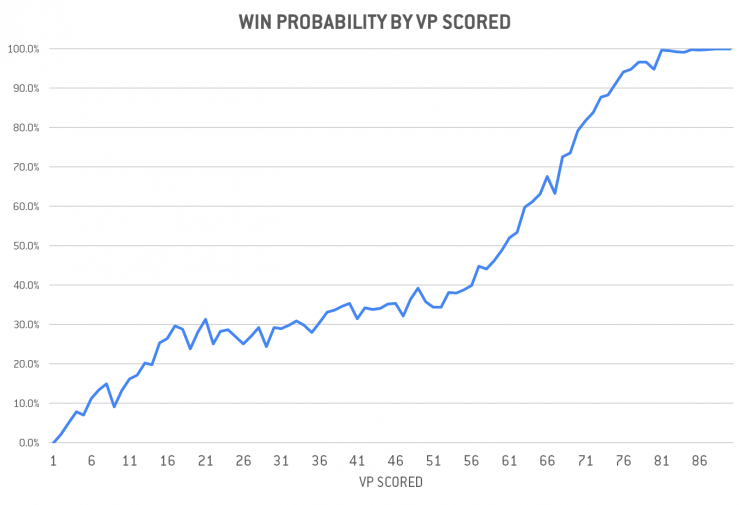
This has some pretty interesting consequences – first, notice the sharp change in slope around the 55-point mark on that graph. Your chances of winning the game increase by an average of 2% for each Victory Point you score above 54. So if you find yourself late on turn 3 or early turn 4 wondering if it’s worth it to try and score 1-2 extra points, it just might make the difference.
Second, because of how scoring works – Primary VP are scored in batches of 5 and capped at 15, starting on turn 2 – there are some nuances to how many VP players can really score. Functionally the game gives you four full turns for scoring, which means that to score 70 points across your primary and secondary objectives it can be helpful to think of the game as a series of 20-point turns (OK, technically 17-18ish but let’s dream big here), that need to happen on turns 2 through 5. Effectively, you can think about planning your game around how you’re going to score 20 points each turn on turns 2 through 5 and have a pretty good strategy for winning the game – this means you can think of turn 1 as setting up for a 20-point turn 2, taking action to do the same on turn 3, and so on. On average, winning players generate about 10 points from primary objectives per turn on turns 2 through 4, and given how difficult “hold more” can be on some missions, that makes a lot of sense.
What this means is that in an average game, you can plan on trying to score around 30-35 points for your primary objectives and in order to secure a win you’ll need to at the very least be able to score another 35 off your secondary objectives. Your secondary objective picks should ideally give you the opportunity to score at least 35 points – and while yes, the number of objectives that have a hard cap are few, there will often be cases where you have an option to take Assassinate or Bring it Down with only 8-10 points as a practical maximum. If your secondaries aren’t giving you that chance, or if you’re not pursuing them in a way that lets you consistently achieve 30+ points from your secondary objectives, it may be time to rethink your army or secondary selections.
Thanks for reading! If you have any feedback, feel free to drop a note in the comments below or email us at contact@goonhammer.com. If you have any questions that you would like answered in a future article like this one, please submit them here.

